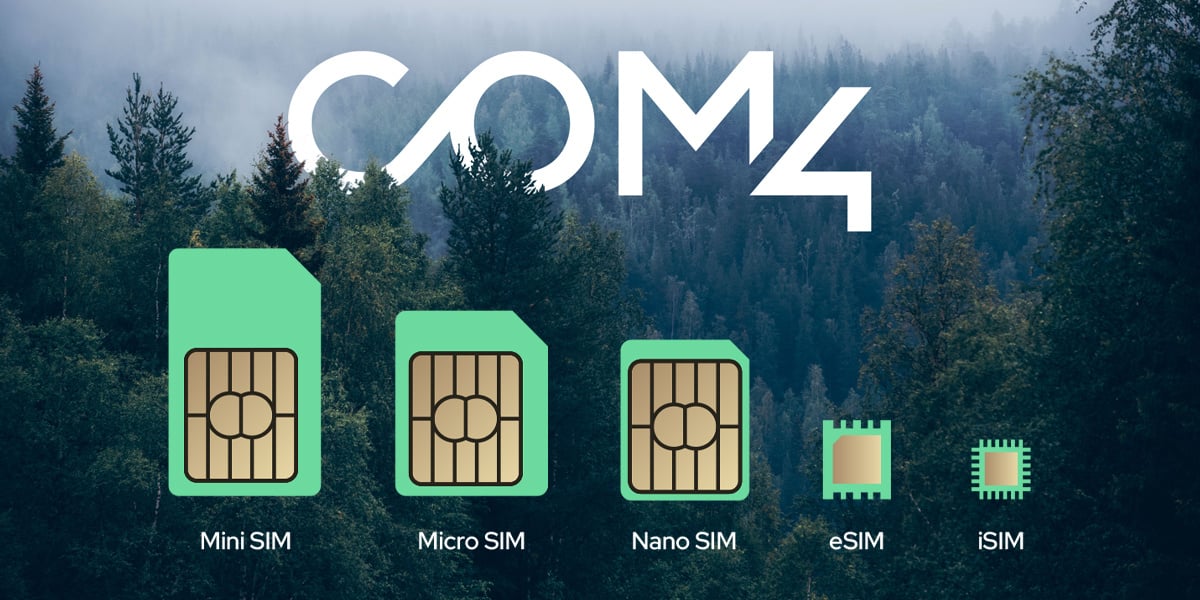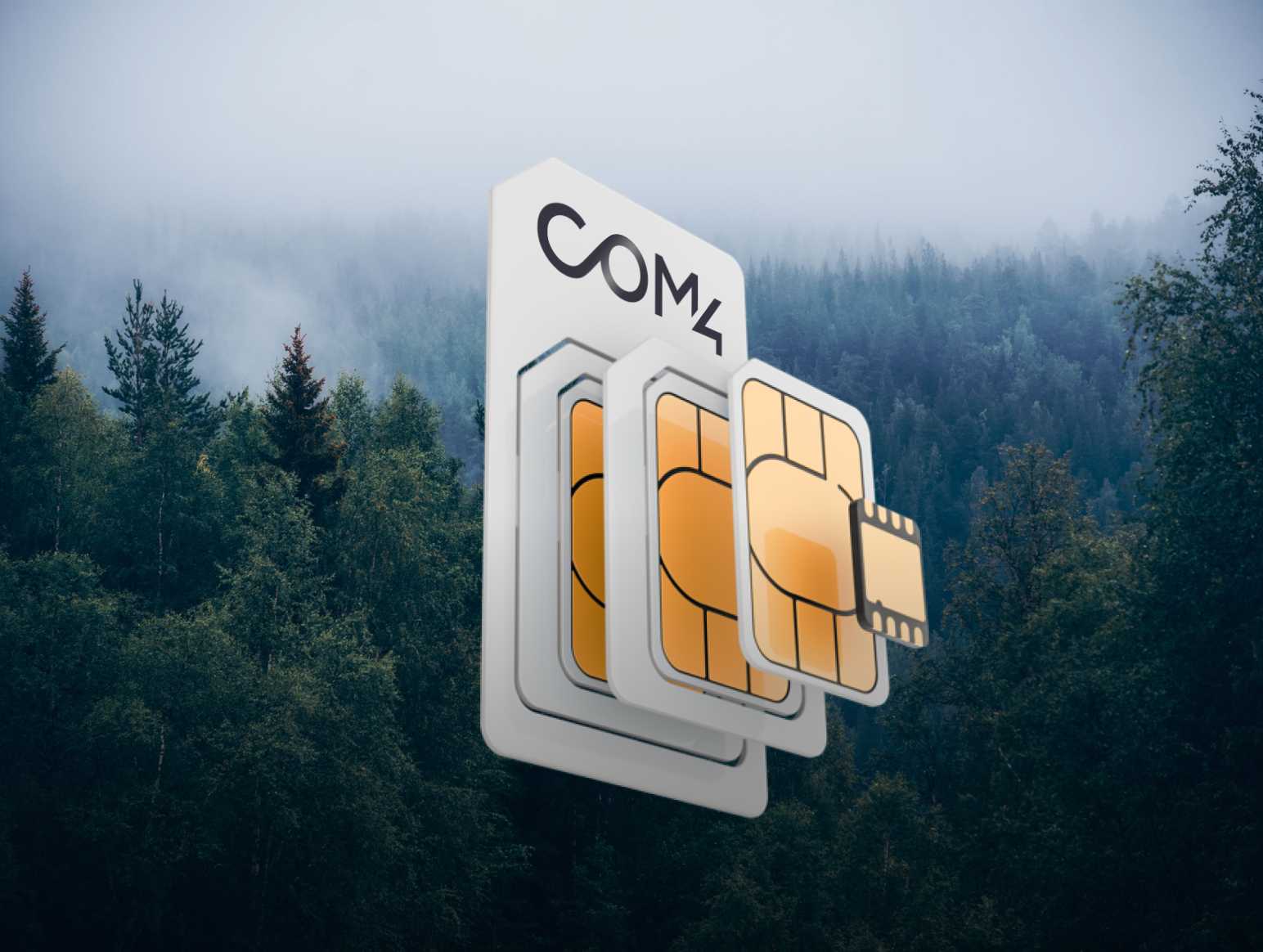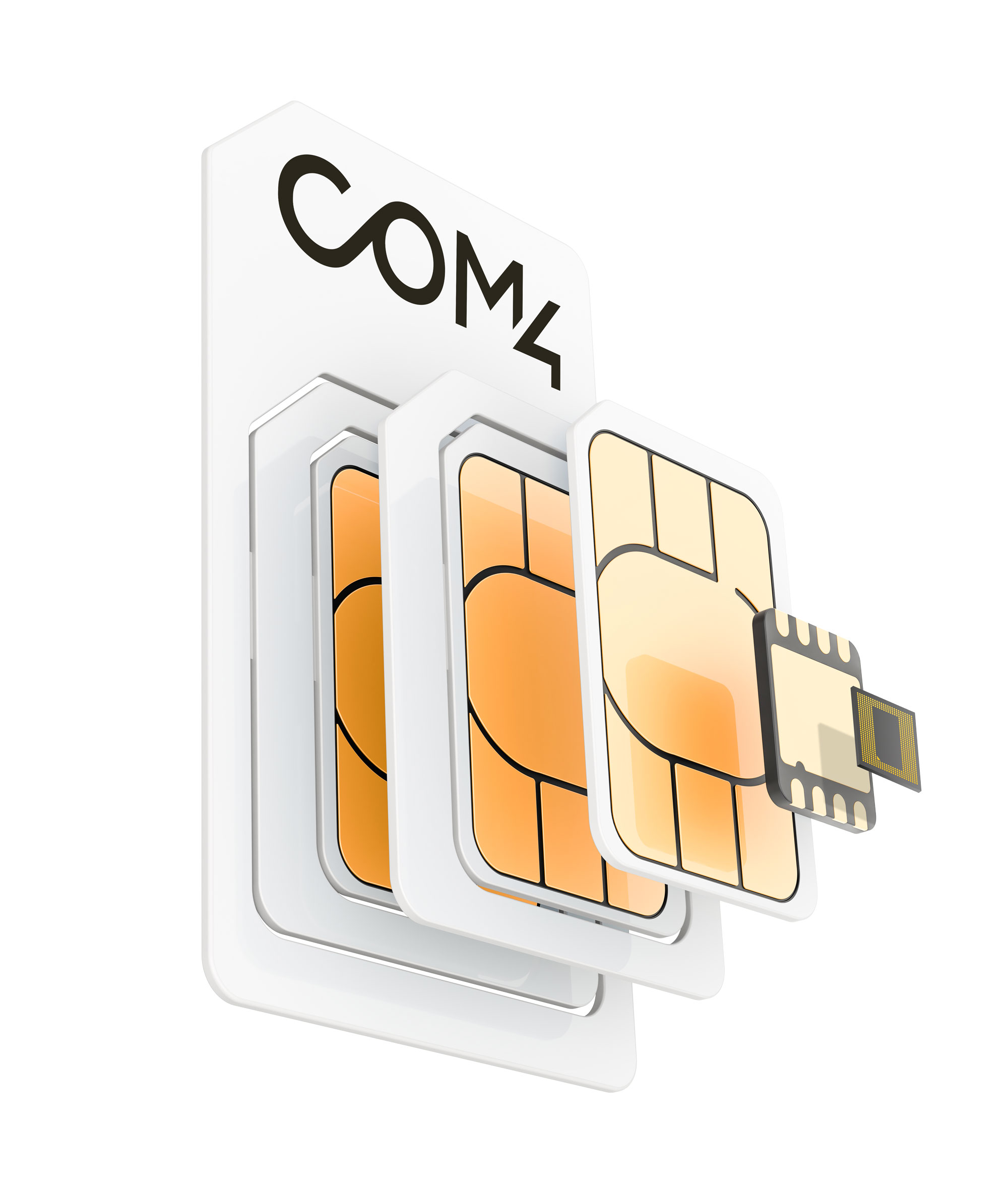This guide explores each technology, highlighting their differences and the implications for IoT strategies.
Table of Contents
-
Overview of SIM Card Architecture Standards
-
What is a SIM?
-
Exploring eSIM Technology
-
Understanding iSIM: The Next Step in SIM Technology
-
Key Differences and Considerations for SIM, eSIM, and iSIM
-
How Com4 Can Support Your IoT Connectivity Needs

Overview of SIM Card Architecture Standards
ICC: Once a primary standard for IoT connectivity, ICC has become largely obsolete and is rarely used today. This standard is limited to GSM and 2G networks, so you’re unlikely to encounter it when selecting SIM cards for modern IoT systems.
UICC: UICC is the most prevalent SIM software standard, compatible with a wide range of networks, including GSM/2G, 3G, 4G, 5G, LTE Cat 1 bis, LTE-M, and NB-IoT. However, UICC cards support only a single operator profile, which can present challenges for achieving global coverage and avoiding issues with permanent roaming.
eUICC: The eUICC standard enables remote provisioning of carrier profiles directly on the SIM. This software works across all SIM form factors (from 2FF to MFF2 embedded SIMs). However, it’s important to note that having an embedded SIM (eSIM) doesn’t necessarily mean it’s eUICC-enabled, and vice versa.
iUICC: stands for Integrated Universal Integrated Circuit Card. This standard represents an advanced form of SIM technology that further integrates the SIM functionality directly into the hardware of a device's main chipset. It builds upon the concept of eUICC (embedded UICC) and iSIM (integrated SIM) to support flexible and highly secure connectivity for IoT and other mobile applications.
What is a SIM?
A Subscriber Identity Module (SIM) is a critical component in IoT connectivity solutions, functioning as a smart card that securely stores data necessary for devices to connect to cellular network technology. This data includes encryption keys, security algorithms, and identifiers, such as the International Mobile Subscriber Identity (IMSI), enabling secure communication with mobile networks.
Typically, when we refer to a SIM, we're talking about the physical card that fits into a slot on a device. These cards are available in different sizes: mini (2FF), micro (3FF), and nano (4FF). For applications where space and durability are critical, the embedded SIM (MFF2) provides a more robust solution by being soldered directly onto the device’s circuit board. This embedded SIM is often used in industrial IoT systems where environmental resilience is vital.
However, traditional SIMs have certain limitations. They usually come with a single, pre-configured network identity, which restricts their flexibility in a dynamic IoT landscape. If your IoT devices are deployed in remote locations, replacing or upgrading SIMs can be both time-consuming and costly. Challenges related to network coverage changes, technology upgrades, or regulatory requirements can disrupt service if the SIM cannot be easily replaced.
Exploring eSIM Technology
eSIM technology (embedded SIM) advances traditional SIM functionality by enabling remote management. Instead of requiring a physical card swap, an eSIM allows for over-the-air (OTA) updates. This means network profiles can be remotely downloaded and activated, providing a level of flexibility not achievable with traditional SIMs.
In consumer applications, eSIMs are often implemented as software profiles, which users can download onto devices like smartphones or tablets. In the IoT world, however, eSIMs still involve a physical component—usually in the form of an M2M eUICC, compliant with GSMA standards. This version of eSIM is specifically designed for machine-to-machine (M2M) applications, allowing for remote network provisioning and seamless updates for features like 5G, LTE-M, and NB-IoT.
eSIMs offer more than just OTA updates. Embedded within devices, they are better protected against harsh environmental conditions compared to traditional SIMs, which makes them ideal for industrial IoT solutions. The ability to adjust network settings, add new functionalities, or change coverage remotely significantly extends the device’s lifespan and maintains uninterrupted IoT connectivity.
Despite these advantages, eSIMs have their challenges. Older devices may lack OTA compatibility, and the initial cost of eSIMs can be higher due to their advanced remote management capabilities. Nonetheless, the long-term benefits in terms of flexibility and reliability make them a compelling choice for IoT deployments that require resilience and future-proofing.
Understanding iSIM: The Next Step in SIM Technology
The Integrated Subscriber Identity Module (iSIM) represents the latest advancement in IoT SIM technology, taking integration one step further. Unlike eSIM, iSIM functionality is embedded directly onto the System-on-Chip (SoC), eliminating the need for a separate SIM slot or physical card. This integration reduces component size and strengthens security by using Tamper-Resistant Elements (TRE).
The iSIM offers all the benefits of an eSIM, including OTA updates and flexible network management, while streamlining device design for industries that demand compact devices, such as healthcare and environmental monitoring. With iSIM for IoT, security is enhanced, and devices can be designed smaller and more efficiently—valuable in fields that require advanced sensor technology.
We offer an iSIM Evaluation Kit designed to let you explore the transformative potential of iSIM technology firsthand. This comprehensive, out-of-the-box solution enables customers to test iSIM integration on their devices before scaling to full deployment. Featuring secure iSIM OS, a state-of-the-art module and chipset, and seamless connectivity through Com4's advanced platform, the iSIM Evaluation Kit allows you to evaluate how iSIM can optimize space, power, and security in your IoT applications.
Key Differences and Considerations for SIM, eSIM, and iSIM
Choosing between SIM, eSIM, and iSIM depends on the specific requirements of your IoT deployment. Traditional SIM cards provide a cost-effective IoT solution but lack flexibility for large-scale or remote deployments. The eSIM adds IoT connectivity management capabilities through remote provisioning, making it ideal for large-scale IoT projects where devices are inaccessible or deployed in harsh conditions.
In contrast, iSIM offers unparalleled flexibility and integration by embedding SIM functionality directly onto the SoC. This minimizes device size and complexity, enhances security, and streamlines manufacturing. However, with iSIM still in its infancy, adoption may be limited until the technology becomes more affordable and accessible.
How Com4 Can Support Your IoT Connectivity Needs
At Com4, we offer a comprehensive range of IoT connectivity solutions to help you navigate the evolving landscape of SIM technology. Whether you require traditional SIM cards, advanced eSIM options, or are exploring the possibilities of iSIM for IoT, our solutions are designed to provide reliable, secure, and scalable connectivity across various applications. Our IoT SIM offerings include global coverage with access to over 750 networks in more than 180 countries, ensuring your devices stay connected wherever they are.
We recognize that choosing the right SIM technology is crucial to the success of your IoT deployment, which is why we provide tailored solutions for every project. Our Free IoT Test Kit allows you to try up to 5 SIM cards with 100 MB of data per SIM for a 60-day period, compatible with multiple technologies, including 2G/3G/4G/5G, LTE-M, and NB-IoT. This kit is an excellent opportunity to test the waters before making a larger investment.
 Transform Your IoT Experience with Com4
Transform Your IoT Experience with Com4
With our extensive range of SIM options, Com4 is committed to helping you achieve seamless IoT connectivity and operational efficiency for your IoT devices. Whether you need support with industrial IoT hardware, IoT security solutions, or remote IoT device management, our solutions ensure that your devices remain connected across networks and regions. As your trusted partner, we enable you to adapt to changing environments and technological advancements.
Contact us today to learn more about how Com4’s SIM, eSIM, and iSIM solutions can elevate your IoT strategy, keeping your devices connected, secure, and scalable—no matter where your deployment takes you.

 CASE STUDY
CASE STUDY









.jpg)